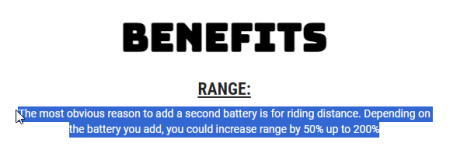
Warning. this is technically impossible. At most a lithium battery can tolerate 15-25% energy loss ( becomes heat ), depending on the chemistry, before catching on fire. It is technically impossible that such a device could save this much power because a battery would shut down ( hopefully ) or catch fire before that happened.
This would be the ideal device to stretch out an old saggy battery by pairing it with a stronger battery but if you are buying a new one, this isn't the case.
I'm kind of dubious now, i suggest you look for long term experiences with these before you buy; maybe they are legit but IDK.
When i see a seller making claims like that, i think this is more of a marketing company than an engineering company, let's say

I already have a 52v 20ah 40a continuous battery that came with my bike. How would I know how to spec my 2nd battery correctly?
Yes, take the maximum continuous current of the smaller motor, double it, and find a battery that meets that 2x the output you need spec. This will result in ~5% energy loss which is acceptable.
Ideally i like 4x the output power i need because the voltage drop will be more like a volt or two at most, somewhere in the 98-99% efficiency range is pretty nice out of the gate; as the battery ages and the internal resistance goes up ( resulting in more sag ), i still have plenty of headroom and therefore
Worst case scenario for selecting a battery is putting a 40a motor on a 40a output battery.. in these conditions you can be losing 10-15% efficiency at peak power.. and freezing temperatures can cut your amp output by 1/4th so in those situations, a battery with 'just enough power' at ambient temperatures becomes one that is inadequate when the cold comes. Not so much with the 4x overspecced battery









